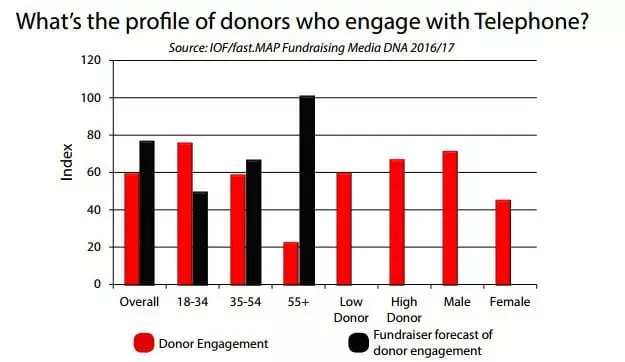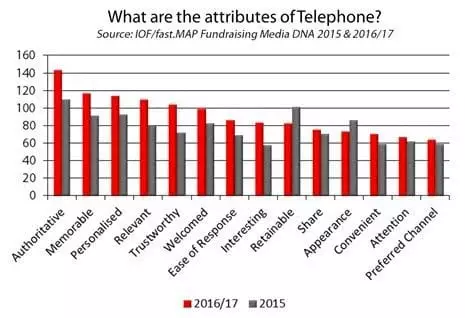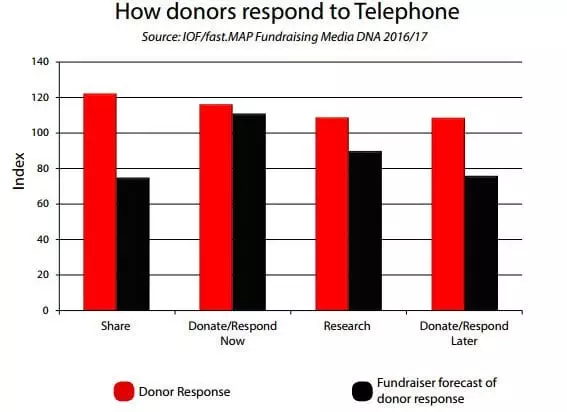Fundraising Media DNA 2016/17 – telephone fundraising: who’s listening?
Charities, particularly those who invest in telephone fundraising, may be pleased to find that telephone is particularly ‘action-prompting’ amongst donors, according to new research findings.
While telephone has strong potential to get results, findings also suggest that fundraisers may not be making the most of this channel as a result of their misunderstanding of how donors interact with it.
The Institute of Fundraising and fast.MAP’s Fundraising Media DNA 2016/17 report provides a source of help, showcasing insight into how donors perceive, engage and respond to telephone as explored below.
(UK Fundraising readers can download the report for free using the code: UKFU16).
Donors’ engagement with telephone
Findings show that fundraisers tend to misjudge how different age groups engage with telephone. While they overestimate 55+s engagement with the channel (Engagement Index; 55+, Actual 23 vs. Expectation 101), they underestimate young people’s engagement (Engagement Index; 18-34, Actual 76 vs. Expectation 50).
Underestimating young people’s engagement with telephone fundraising leaves room for missed opportunities. With 18-34s being identified as the age group that engages with this channel the most, it’s important that they are particularly considered when devising campaigns.
Interestingly, findings also reveal differences in engagement in terms of gender, with men found to engage more with telephone fundraising than women (Engagement Index; Male, 71 vs. Female 45).
Donors’ perception of telephone
In relation to how telephone fundraising is perceived, ‘memorable’, ‘personalised’, ‘relevant’ and ‘trustworthy’ are amongst the top attributes that people associate with this medium.
However, ‘authoritative’ is the top attribute that most donors and potential donors associate with this medium (Authoritative Index; Overall,143). 55+s (Authoritative Index; 55+,199) and women (Authoritative Index; Female,191) in particular, make this association. Fundraisers who want to boost the credibility of their campaigns may thus find it useful to incorporate telephone into their plans.
In addition to perceiving this channel as highly authoritative, women find telephone fundraising to be very personalised (Personalised Index; Female, 144), more so than men (Personalised Index; Male, 95).
35-54s is the age group that finds telephone fundraising most relevant (Relevant Index; 35-54, 145).
Low-value donors also find telephone fundraising more relevant than high-value donors (Relevant Index; Low donor, 140 vs. High donor, 107).
Similarly, such differences exist in terms of people’s perception of telephone as a trustworthy, fundraising channel. While this channel is generally seen as trustworthy (Trustworthy Index; Overall, 104), low-value donors perceive it as more trustworthy than high-value donors (Trustworthy Index; Low donor, 134 vs. High donor, 89). 35-54 year olds are also the age group that are most likely to see telephone fundraising as trustworthy.
Advertisement
Donors’ response to telephone
Findings show that people respond to telephone fundraising at above average levels.
While fundraisers underestimate people’s likeliness to share the information they’ve heard via telephone (Share Index; Overall, Expectation 75), this was found to be the most common response people have (Share Index; Overall, 122). 55+s are most likely to respond in this way (Share Index; 55+, 152). Fundraisers aiming to raise awareness about their campaigns may thus find using telephone beneficial.
People’s likeliness to research further (Research Index; Overall, Expectation 90) or donate/respond later (Donate/Respond Later Index; Overall, Expectation 76) to telephone fundraising was also underestimated by fundraisers. Findings show that these actions are also taken at above average levels (Research Index; Overall, Actual 109) and (Donate/Respond Later Index; Overall, Actual 109).
Fundraisers anticipated that donating or responding immediately would be the most common response to telephone fundraising (Donate/Respond Now Index; Overall, Expectation 116). They weren’t far off, as this was found to be the second most likely response that people have to telephone fundraising.
Industry views on telephone
“This research demonstrates the actions being taken have resulted in marked progress as to how the telephone is perceived by the public, with double digit improvements in most of the engagement criteria and all response criteria continuing to over index for the second consecutive year.
It is particularly pleasing to see how much more memorable, personalised and relevant the calls have become and this reflects changes to how calls are scripted, and highlights the ongoing importance of the phone to positively engage with the public.”
Tony Charalambides, Managing Director, Listen Fundraising
To find out more about how people view and interact with various fundraising channels, including telephone, download Fundraising Media DNA 2016/17 – free (normally £50) with the following code: UKFU16.






